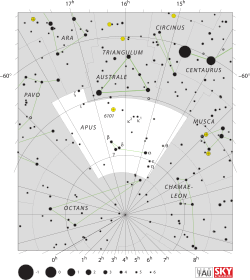Alpha Apodis
Alpha Apodis (Alpha Aps, α Apodis, α Aps) is the brightest star in the southern circumpolar constellation of Apus, with an apparent magnitude of approximately 3.825.[10] It had the Greek alpha designation as part of the constellation which Johann Bayer called Apis Indica in his 1603 Uranometria star atlas.[11] With a declination of –79°, this is a circumpolar star for much of the southern hemisphere. It can be identified on the night sky by drawing an imaginary line through Alpha Centauri and Alpha Circini then extending it toward the south celestial pole.[12]
 | |
| Observation data Epoch J2000.0 Equinox J2000.0 (ICRS) | |
|---|---|
| Constellation | Apus |
| Right ascension | 14h 47m 51.71203s[1] |
| Declination | −79° 02′ 41.1032″[1] |
| Apparent magnitude (V) | 3.825[2] |
| Characteristics | |
| Spectral type | K2.5III[2] |
| U−B color index | +1.68[3] |
| B−V color index | +1.43[3] |
| R−I color index | +0.53[4] |
| Astrometry | |
| Radial velocity (Rv) | −1.1[5] km/s |
| Proper motion (μ) | RA: −7.395[6] mas/yr Dec.: −15.726[6] mas/yr |
| Parallax (π) | 7.5519 ± 0.3237[6] mas |
| Distance | 430 ± 20 ly (132 ± 6 pc) |
| Absolute magnitude (MV) | −1.67[7] |
| Details | |
| Radius | 48[8] R☉ |
| Luminosity | 928[9] L☉ |
| Luminosity (bolometric) | 980[10] L☉ |
| Temperature | 4,312[9] K |
| Other designations | |
| Database references | |
| SIMBAD | data |
This is a giant star with a stellar classification of K2.5III, indicating that this star has consumed the hydrogen at its core and has evolved away from the main sequence. It has expanded to an estimated radius of about 48 times the radius of the Sun and is emitting 980 times the Sun's luminosity. The photosphere has an effective temperature of 4,256 K, giving the star the characteristic orange hue of a K-type star.[13] Based upon parallax measurements, this star is 430 ± 20 light-years from the Earth.[6] It is not known to have a companion.[14]
Naming
In Chinese caused by adaptation of the European southern hemisphere constellations into the Chinese system, 異雀 (Yì Què), meaning Exotic Bird, refers to an asterism consisting of α Apodis, ζ Apodis, ι Apodis, β Apodis, γ Apodis, δ Octantis, δ1 Apodis, η Apodis, and ε Apodis. Consequently, α Apodis itself is known as 異雀八 (Yì Què bā, English: the Eighth Star of Exotic Bird.)[15]
References
- van Leeuwen, F. (November 2007), "Validation of the new Hipparcos reduction", Astronomy and Astrophysics, 474 (2): 653–664, arXiv:0708.1752, Bibcode:2007A&A...474..653V, doi:10.1051/0004-6361:20078357.
- "alf Aps -- Star", SIMBAD, Centre de Données astronomiques de Strasbourg, retrieved 2011-12-23.
- Johnson, H. L.; et al. (1966). "UBVRIJKL photometry of the bright stars". Communications of the Lunar and Planetary Laboratory. 4 (99). Bibcode:1966CoLPL...4...99J.
- HR 5470, database entry, The Bright Star Catalogue, 5th Revised Ed. (Preliminary Version), D. Hoffleit and W. H. Warren, Jr., CDS ID V/50. Accessed online October 3, 2008.
- Evans, D. S. (June 20–24, 1966), Batten, Alan Henry; Heard, John Frederick (eds.), "The Revision of the General Catalogue of Radial Velocities", Determination of Radial Velocities and their Applications, Proceedings from IAU Symposium no. 30, University of Toronto: International Astronomical Union, Bibcode:1967IAUS...30...57E.
- Brown, A. G. A.; et al. (Gaia collaboration) (August 2018). "Gaia Data Release 2: Summary of the contents and survey properties". Astronomy & Astrophysics. 616. A1. arXiv:1804.09365. Bibcode:2018A&A...616A...1G. doi:10.1051/0004-6361/201833051.
- Cardini, D. (January 2005), "Mg II chromospheric radiative loss rates in cool active and quiet stars", Astronomy and Astrophysics, 430: 303–311, arXiv:astro-ph/0409683, Bibcode:2005A&A...430..303C, doi:10.1051/0004-6361:20041440.
- Pasinetti Fracassini, L. E.; et al. (February 2001), "Catalogue of Apparent Diameters and Absolute Radii of Stars (CADARS)", Astronomy and Astrophysics (Third ed.), 367: 521–524, arXiv:astro-ph/0012289, Bibcode:2001A&A...367..521P, doi:10.1051/0004-6361:20000451.
- McDonald, I.; et al. (2012). "Fundamental Parameters and Infrared Excesses of Hipparcos Stars". Monthly Notices of the Royal Astronomical Society. 427 (1): 343–57. arXiv:1208.2037. Bibcode:2012MNRAS.427..343M. doi:10.1111/j.1365-2966.2012.21873.x.
- Kaler, James B., "Alpha Aps", Stars, University of Illinois, archived from the original on 2008-12-02, retrieved 2011-12-23.
- Ridpath, Ian, "Apus, the bird of paradise", Ian Ridpath's Star Tales, retrieved 2011-12-25.
- Moore, Patrick (2000), Exploring the night sky with binoculars (4th ed.), Cambridge University Press, p. 113, ISBN 0-521-79390-4.
- "The Colour of Stars", Australia Telescope, Outreach and Education, Commonwealth Scientific and Industrial Research Organisation, December 21, 2004, archived from the original on February 22, 2012, retrieved 2012-01-16.
- Eggleton, P. P.; Tokovinin, A. A. (September 2008), "A catalogue of multiplicity among bright stellar systems", Monthly Notices of the Royal Astronomical Society, 389 (2): 869–879, arXiv:0806.2878, Bibcode:2008MNRAS.389..869E, doi:10.1111/j.1365-2966.2008.13596.x.
- (in Chinese) AEEA (Activities of Exhibition and Education in Astronomy) 天文教育資訊網 2006 年 7 月 29 日